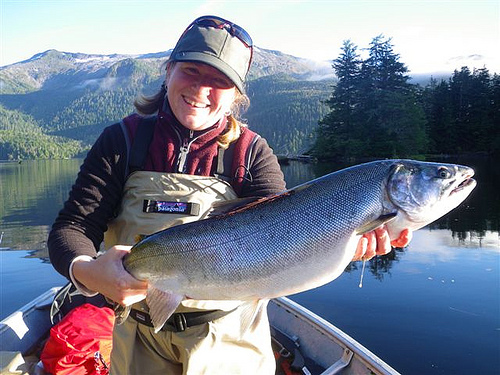
Redoubt is not just about sockeye. Megan Gahl holds another bright coho for the freezer. (USFS Photo/Darrin Kelly)
While Sealaska vice-president Rick Harris was in Sitka last Wednesday (3-13-13) to promote a revised land selection bill now before Congress (S.340), he also used the opportunity to address many Sitkans’ top concern with the corporation: Its decision to select land — through separate legislation — at Redoubt Lake Falls.
Listen to iFriendly audio.
The regional Native corporation selected the site under Section 14(H)(1) of the Alaska Native Claims Settlement Act — in 1976. The conveyance has been percolating in the federal bureaucracy ever since.
The arrival of a survey team from the Bureau of Land Management in 2011 galvanized local response to the selection.
Harris told the Sitka Chamber of Commerce that the decision to choose Redoubt was made by the original Sealaska board members from Sitka. That news was overshadowed by more recent strong reactions.
“As soon as we walked into it everyone assumed the worst: That is, the end of the sockeye subsistence fishery. That was not our intent, and we didn’t expect that.”
The main difference between Redoubt Falls — then and now — is the US Forest Service’s lake fertilization program. Over the past two decades, the Redoubt system has become one of the most important — if not the most important — subsistence sockeye areas for Sitka.
Harris said fears that Sealaska would privatize the falls, or restrict access, were unfounded.
“That site should be continued to be managed as a site that is available for the sockeye enhancement program to continue, and for the public at large to be able to continue to use that site for the sockeye subsistence fishery.”
In response to questions from the audience, Harris also said that the deed restrictions and covenants for the sites prohibited logging. Last year, the trustees of the former Sheldon Jackson College filed a “color of title” claim on the site, to block the corporation’s selection. Harris told the Chamber he thought Sealaska was the better deal.
“If they buy it or if they receive it, it wouldn’t come with any of the protections it would have from Sealaska. If we receive title, we cannot allow uses that are incompatible or inconsistent with the purpose for which the site is conveyed. The site is being conveyed to us as a site for a subsistence sockeye fishery. So we feel — and we’ve tested this — it is permissible to have public use, public access, and to continue with the sockeye enhancement program.”
An audience member asked Harris outright if Sealaska would log Redoubt. He replied, “If I even acted like we logging one of those sites, then I wouldn’t be standing in this room.” He also said other development — like tourism lodges — were prohibited under the section of federal law that allows Sealaska’s selection.






























